A press release from the Buffalo Field Campaign described a proposal for the tribes to develop a plan to assume “primary jurisdiction” over Yellowstone National Park’s bison.
The first question anyone should ask is why any group, especially one based on a racial preference, should be given control of public wildlife.
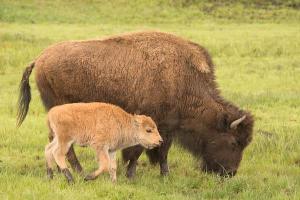
Yellowstone bison are unique. They are the least “domesticated” of all bison in the United States/George Wuerthner
The Yellowstone bison do not belong to the tribes. Wildlife is held in trust as part of the Public Trust Doctrine, and there is no reason why tribes should be given any greater authority or influence than any other American citizens. All tribal members are U.S. citizens and share the same access to public comment and influence as all other Americans.
The tribes and BFC are using bison as a pretext to further tribal interests and control of public lands and wildlife. The bison are pawns in this effort. Make no mistake. BFC is not concerned about bison welfare but tribal welfare.
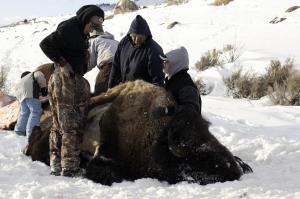
A bison killed by tribal hunters outside of Yellowstone/George Wuerthner
These public lands are part of our democratic heritage that belongs to all citizens, and I would suggest they are a global heritage that belongs to no one. They are under increasing threat from well-meaning people who see the public domain as political chips of the social justice movement.
We already know what happens when you give legal or otherwise concede authority to any interest group —ranchers, miners, loggers, ATVers, etc. — all have undue influence over public land management. We do not need yet another group that will have greater control of what is a public resource.
Most tribes do not manage their lands or wildlife in an exemplary fashion. When money is to be made, they act like all other humans-they put their self-interest first.
BFC advocacy for bison restoration is a subterfuge for expanding tribal power over public resources. One doesn’t need jurisdiction over bison to advocate for bison well-being. To see footage of recent tribal bison slaughter view this video from Yellowstone Voices.
BFC calls for the expansion of bison on public lands. On the surface, I certainly agree with the goal of bison restoration on public lands. But this goal should be for what is appropriate for wild bison, not what is good for the tribes. The Wild Bison Coalition calls for bison restoration on the Charles M. Russell National Wildlife Refuge. Tribal members can support such policies, without assuming “primary jurisdiction” over bison to promote bison restoration
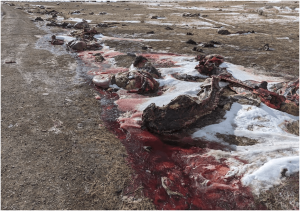
Bison carcasses as evidence of tribal bison slaughter along road near Gardiner, Montana
The Buffalo Field Campaign [release] talks about cultural restoration. It is deceit and disingenuous to justify killing under the guise of culture. If culture is a valid reason for killing wildlife, would that mean the killing of elephants in Africa, the clubbing of seals by Newfoundlander fishermen, or the slaughter of whales by Japanese whalers, all cultural traditions in their countries, are equally valid?
Culture is not science; our wildlife should be managed on scientific principles, not religion or cultural justifications.
The BFC argues that the tribes should manage public bison using “traditional ecological knowledge.” Was the slaughter of more than a thousand bison outside Yellowstone Park this past winter an example of traditional ecological knowledge?
Remember that tribal hide hunting in the 1800s was responsible for the extirpation of bison in many parts of the West long before the final coup de grace resulting from commercial bison hunters in the 1870s. Indian hunting wiped out bison in Utah, Idaho, western Wyoming, western and southwestern Montana, North Dakota, Manitoba, and Minnesota by the 1850s.
This was long before most of these areas had any white settlement or commercial hide hunting, which did not begin in any effective manner until the 1870s after the Civil War when railroads penetrated the West, enabling the transportation of heavy hides to the East.
Because tribal people believed that bison annually repopulated the plains from a hole in the ground each spring, they could not conceive of overkill. Superstition and religion guided their relationship with bison, and hunting success would continue if one did the correct dance and followed the proper procedures.
Do we really want superstition and religion to guide wildlife policy in the United States? I would suggest this is a grave step backward.
Plenty of other evidence exists for tribal ecological impacts, notwithstanding “traditional ecological knowledge.” Tribal people are like the rest of the human race, and prone to over-exploitation of natural resources—if and when they can.
For instance, Mayan deforestation led to a significant decline in soil carbon in Central America, Indian exploitation of sturgeon led to a reduction in population, California tribes reduced the apparent distribution and numbers of elk, and paleo hunters are often one of the factors that drove some Pleistocene extinctions. Even today, Indigenous hunting of beluga whales in Cook Inlet is cited as a significant contributing factor in the whales’ decline from 1,300 in the 1970s to less than 300 animals today, among many other examples I could mention. Obviously “traditional ecological knowledge” doesn’t preclude over-exploitation of the land.
Buffalo Field Campaign has repeatedly demonstrated that it does not put the bison first; it puts tribal interest first.
It’s time we give more consideration to the non-human entities we live among.
Yellowstone bison are unique. They are not like most other bison in the West. They are the least domesticated animals we have. The tribes do not concern themselves with wildness. Indeed, all tribal herds are domesticated animals and treated like livestock.
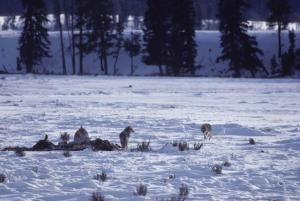
Coyotes feasting on a bison carcass. When tribal hunters remove bison from the ecosystem, they are literally taking the food out of the mouth of numerous dependent wildlife from wolves to grizzlies to ravens and coyotes/George Wuerthner
BFC has ignored the numerous ecological impacts of tribal bison slaughter near Gardiner, Montana, to promote tribal interests. The tribal massacre this winter removed biomass from the park ecosystem that would have sustained bears, wolves, and other wildlife. It reduced the population dangerously low with genetic implications; a reduction in bison numbers exacerbated by bison being tournament breeders, and one male can impregnate a dozen or more females, significantly reducing genetic diversity. It selectively killed the very animals that are most likely to migrate. Tribal slaughter altered the age and sex structure of the herds since, under “natural” conditions, the young and old are the animals that naturally suffer mortality. (All removals have the same influence, including the capture and slaughter by National Park Service or the Montana Department of Livestock).
Remember that of the nearly 500,000 bison found outside of Yellowstone, all are “farmed” like other livestock. The Yellowstone bison are a tiny and unique subset of bison.
Imagine if all the salmon in the West were raised in hatcheries and you only had less than 1 percent of wild fish. Would we permit killing 25 percent of this small number of “wild” salmon? Yet this is precisely what the BFC advocates.
That is precisely what the BFC and tribes say is OK for “cultural” reasons.
And as far as preserving “culture” is concerned, there is far more to culture than merely killing animals. Using modern weapons, trucks, ATVs, drones, etc., negates any claim that you are preserving “culture.” All you are preserving is killing. And you don’t have to kill Yellowstone wild bison if killing a bison is your goal. There are plenty of farmed buffalo on private ranches, tribal lands, etc. that are available for slaughter.
Regarding treaties, none of the tribes in the West has a legal right to hunt bison in Yellowstone. The so-called treaty rights are privileges in reality. Tribal advocates extract clauses from the treaties without providing the full context or legal decisions that refine the meaning of treaties.
Proponents argue that these privileges give tribes the right to hunt any place on so-called “open and unoccupied” public lands (Forest Service and Bureau of Land Management). These privileges are limited to “ceded lands.” There are no tribal ceded lands anywhere in southwestern Montana, much less near Gardiner, immediately adjacent to Yellowstone.
Some tribes in the Columbia Basin were given the right to fish at selective locations, like waterfalls where tribal people customarily sought salmon off reservations. Still, this privilege does not apply to hunting.
Furthermore, even this is restricted by a court decision that asserts that any tribe claiming such a privilege must demonstrate “occupation” to the exclusion of other tribes. No tribe can make such a claim for hunting anyplace on public lands in or around Yellowstone.
Finally, there was a Supreme Court decision led by none other than [Justice] William O. Douglas that says even in the places where treaties do give tribes legitimate authority to kill wildlife off of reservations, tribes cannot harm the survival of the species.
This landmark judgment on treaties held that the federal government may regulate treaty fishing rights in the interest of conservation, so long as the said regulation is reasonable and necessary as well as non-discriminatory against Native Americans [Puyallup Tribe v Washington Department of Fish and Game 391. The US. 392 (1968)]. This same legal argument could be used to halt the tribal killing of Yellowstone bison, which due to their unique wild history, makes them of huge conservation interest.
The problem is that few people or organizations are willing to challenge the tribes — witness the total lack of criticism and silence by almost all conservation groups, such as the Greater Yellowstone Coalition, of the excessive bison slaughter this winter. The tribes are exploiting this lack of critical oversight.
Wildlife is supposed to be managed by the Public Trust Doctrine.
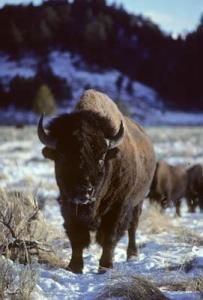
We need wild bison. Yellowstone bison are unique and should be treated with greater respect and protection than they are receiving today/George Wuerthner
We need more wild bison. Tribal interests are not the public interest. Several groups that advocates for bison includes Roam Free Nation and Gallatin Wildlife Assocation.
Those interested in preserving wild bison should join the Wild Bison Coalition.
George Wuerthner has been studying Yellowstone for nearly 50 years. He has published 38 books on national parks and other environmental issues, including Yellowstone—A Visitor’s Companion, Yellowstone and the Fires of Change, Yellowstone in Photographs, and Keeping the Wild: Against the Domestication of the Earth and Protecting the Wild: Parks and Wilderness the Foundation for Conservation. He has worked as Ecological Projects director for the Foundation for Deep Ecology and Tompkins Conservation, promoting parks in Patagonia and elsewhere. Wuerthner taught as a visiting lecturer Alaskan Environmental Politics at the University of California, Santa Cruz, various field ecology classes for San Francisco State University, University of California Santa Barbara, Prescott College, and environmental writing at the University of Vermont.




 Support Essential Coverage of Essential Places
Support Essential Coverage of Essential Places







Comments
I only had to read the first sentence to see where this was going. "The first question anyone should ask is why any group, especially one based on a racial preference, should be given control of public wildlife". Really??????
George Wuerthner is on the money in this Op-Ed..
.
First the colonists destroyed the native people on the east coast in the 17th century and then the Midwest native people in the 18th century and then the 30million bison . That where part of their life.these people live here for 12,000years before people like George weathern decided to forced native Americans to reservations and strip them of their culture and send their childer to indian schools to Americanize them
The author is delusional.. native Americans lived here for 12,000yeare and them and the bison where erased in 300years of colonial oppression
You are wrong about where it was going. The author spelled out many good arguments for keeping Yellowstone Bison Management out of the hands of any special interest group. You should take the time to read the whole piece.
You need to take down this article. It's incredibly offensive and dismissive of Native culture(s) and the unique perspectives of indigeneity as distinct from race. The topic of bison management is complex and nuanced, but that does not give NPT an excuse to dismiss the Native American experience and perspective. Please take down this article.
Well if that isn't an old white male "wildnerness first" mentality I don't know what is. His point about bison management may have merit, but it is lost in lack of understanding of history. It's so wild this got published. Not to mention his tone toward Native Communities. I am not as steeped as others in the Yellowstone bison topic & associated nuances, however the assumptions and lack of acknowledgement of Native American history made here are pretty astounding. Do y'all fact check?
This is a horribly written article that is not only insensitive, but factually incorrect on so many levels. You dismiss The idea of traditional ecological knowledge, when In fact, there are extremely well documented land management teqniques utilized by natives, most notably the annual burning of prairies, which not only creates better bison habitat, but greatly increases plant and animal biodiversity. this exactly mirrors modern Land management techninques. The idea that you think tribes had no concept of overkill is absurd. The natives, more than entire else would have noticed the bison herds diminishing year after year. one of the main reasons for conflicts between the plains tribes and white settlers was the wanton destruction of the bison herds, not to mention the fact that the eradication of the bison herds was literally US military doctrine. You also use pictures of bison slaughters without context purely as tools to grab the readers emotions. You don't take population dynamics into account, and the fact that Yellowstone is a finite park that can only sustain a finite number of bison. Culling is an inevitable necessity. Not nearly enough bison are killed by predators alone. But it became clear that you were operating in emotions instead of facts and science when you refer to bison as "nonhuman entities". And yes, the harvest of animals is very much a valid cultural practice as long as it is sustainabl.